Yogyakarta, often referred to as Jogja, is indeed an incredible destination that captivates visitors with its rich cultural heritage, stunning landscapes and vibrant atmosphere. Here’s why Jogja is truly remarkable:
- Cultural Heritage
- Magnificent Temples
- Natural wonders
- Art and Handicrafts
- Culinary Delights
Overview
Jogja’s incredible blend of cultural heritage, magnificent temples, natural beauty, and culinary delights makes it a truly unforgettable destination. Whether you’re exploring ancient temples, immersing yourself in traditional arts and culture, or indulging in delicious Javanese cuisine, Jogja promises a memorable experience that showcases the best of Indonesia’s cultural diversity and natural wonders.
1. Cultural heritage:
1. Craton Yogyakarta: The Sultan’s Palace is the heart of Jogja’s traditional culture. Visitors can explore the palace complex, learn about Javanese royal history and witness traditional ceremonies and performances.
2. Wayang Kulit (shadow puppetry): Jogja is famous for its traditional Wayang Kulit performances, where intricately crafted leather puppets bring ancient epics and stories to life with music and storytelling.
3. Batik Art: Jogja is famous for its batik, a traditional Indonesian textile art form. Visitors can watch batik-making demonstrations and even try their hand at creating their own designs.
2. Magnificent temples:
1. Prambanan Temple: This UNESCO World Heritage Site is a stunning example of Hindu architecture in Indonesia. The towering temples and intricate carvings depict ancient Hindu epics and deities.
2. Borobudur Temple: The largest Buddhist temple in the world, Borobudur is a marvel of ancient engineering and artistry. Visitors can explore its nine stacked platforms decorated with over 2,500 relief panels and 500 Buddha statues.
3. Natural Wonders:
1. Mount Merapi: Indonesia’s most active volcano, Mount Merapi offers exciting trekking experiences and panoramic views of the surrounding landscape. Visitors can also learn about the volcano’s geological history and ongoing monitoring efforts.
2. Parangtritis Beach: Located south of Jogja, Parangtritis is a picturesque black sand beach known for its stunning sunsets, mystical legends and traditional Javanese horse riding experiences.
4. Arts and crafts:
1. Kotagede: This historic neighbourhood is Jogja’s centre for silver crafts. Visitors can explore traditional silver workshops, buy unique silver jewellery and souvenirs, and learn about the art of silversmithing.
2. Taman Sari Water Castle: Built as a royal garden and pleasure complex, Taman Sari features intricate Javanese architecture, underground tunnels and bathing pools. It’s a fascinating glimpse into Jogja’s royal past.
5. Culinary delights:
1. Gudeg: A traditional Javanese dish made from young jackfruit cooked in coconut milk and spices. Gudeg is often served with rice, chicken, tofu and tempeh.
2. Bakpia: A popular snack in Jogja, bakpia is a sweet pastry filled with various fillings such as mung bean or chocolate.










